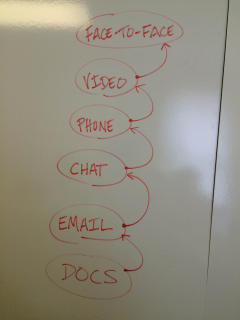Communication in any organization is important–and even more so for a business with a team that works remotely. There is a progression of effectiveness in communication that can help as we think about how to discuss different types of concerns and issues with both coworkers and clients. Knowing which communication medium to use at a certain point in the project life cycle can be very important.
As a remote working company, we need to be great at knowing which communication medium is the most effective to manage project needs. Much of the time, specifications we work from are in Google Docs or work tickets. We’ve found that writing things down is always the best way to make sure the work gets done according to plan. The challenge, though, is making sure that those notes or instructions make sense. Sometimes, even written notes can be unclear or interpreted incorrectly. The reasons behind these types of problems can be varied. Maybe we receive inaccurate information, or sometimes even a simple typo can derail a requirement. Detailing a complex design in plain text can be a demanding task in itself. If things start to get confusing, we pick up the phone for verbal clarification.
Nobody wants a communication error. We always work toward eliminating these types of mistakes in communication by looking for things that don’t sound right or are confusing. So, if something throws up the confusion flag, it is often worth connecting with your stakeholders directly to hash things out. Whether it is in the middle of the project or at the kick-off, stop and try to make sure that things are understood by all involved. Taking the time to clear things up early in the project with a quick phone call can save you quite a bit of time and heartache later.

As previously mentioned, there is a progression, or ladder, of communication effectiveness. In the picture above, I’ve adapted the traditional ladder to something that more closely matches our current mediums of communication. “Documentation/Paper” is at the bottom of the chart, representing the least effective way to communicate. Most people just don’t have the time to read through a long document. Next is “Email”–useful, but easy to misread. “IM/Chat” is better–you get immediate feedback, and the back and forth is much smoother. “Phone/Audio Chat” is highly effective in many circumstances, but, you don’t see others in the conversation to get that valuable visual feedback. “Video Chat” is second most effective, because you’re able to see how they react at different points in the conversation; however, you don’t get the experience of reading their full body gestures and posture. “Face-to-Face” communication is simply the best in terms of effective communication.
So, my advice is to find time to get the people that matter in a room–physically or through the use of technology–and make sure those who are doing the work understand what is being asked of them. Kicking off a project as a team or meeting at a critical point in the process can have other positive side effects. At Red Argyle, gatherings like these often result in team members and clients productively brainstorming together and coming up with new ideas for the project. And that is why face-to-face and voice-to-voice is a very good thing.






